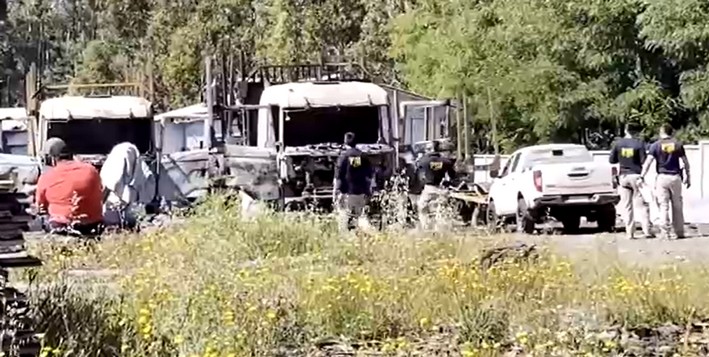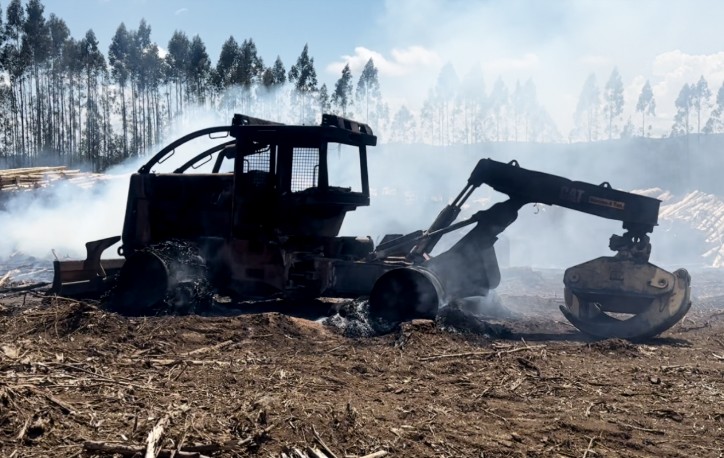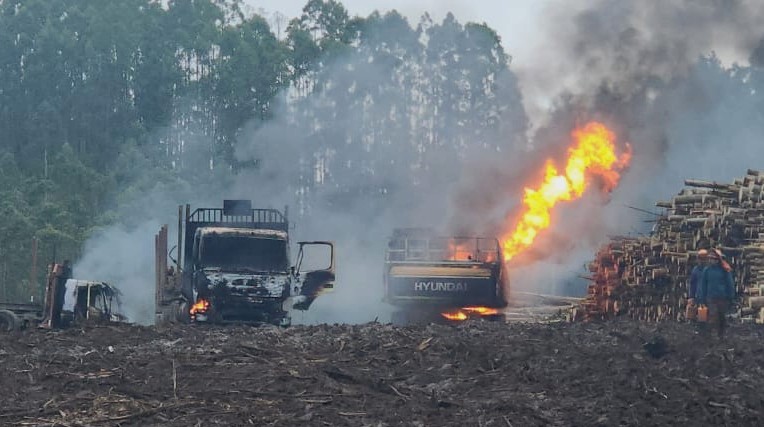"There is a virtuous scenario for dialogue, but we must not be naive and must see reality"
Richard Caifal, Executive Director of the Indigenous Policy Center Rakizuam
Born in the Ricardo Rayin reduction, in Freire, La Araucanía region, this lawyer understood shortly after graduating that the problems of Mapuche communities had a political background. Today, this former candidate for the Constitutional Convention offers a drastic analysis of previous dialogue efforts and their outcomes.
The name of Richard Caifal Piutrín—a Mapuche leader, former governor of Cautín Province, and director at Enama—was recently proposed to join the Technical Secretariat for
Indigenous Participation and Consultation. However, his name faced rejection from the reserved-seat Constituents in the Convention, revealing the division of stances within the Mapuche political world.
Years ago, Caifal formed the Alianza Territorial Mapuche, a more dialogue-oriented group than the CAM, which emerged to work on political demands and public policies. It was the year 2000, and a series of projects were planned on indigenous lands, but the lack of legal awareness meant they were not properly compensated. "There was precarious legislation that did not protect the Mapuche world, except for the Indigenous Law, but without addressing socio-environmental issues until the enforcement of Convention 169." He experienced intimidation, leading him to step away from indigenous issues for a time—but life had other plans.
He later joined the Enama Corporation, where he engaged with legislative aspects, participating in dialogue tables and various advocacy spaces such as the Indigenous Consultation Decree, the Bishop Vargas dialogue table, submitting proposals to the government, drafting the Reserved Seats Law, and serving as a legal advisor for the 2017 constitutional process. "With the Enama Corporation, the work has been more fruitful," explains this Evopoli member and former Governor of Cautín Province, where he witnessed the situation of rural violence victims. "Some people confuse and tarnish what could be a legitimate demand."
How do you characterize the conflict?
Violence, in one way or another, has been present since the State intervened in the region. Our education does not teach what happened in La Araucanía, so it is a political debt—not just a demand for recognition, but a denial of history. We were not taught that there was a civil war in La Araucanía until 1883. Though it was over 100 years ago, collective memory persists. My grandfather was dispossessed of his land, which was given to settlers, leaving my family grouped with others in a reduction. I didn’t read this in a book—my father told me. This led to famine, as we shifted from an individual to a communal logic—by force, not by our own vision or Mapuche worldview. There were many episodes of violence, and this has continued over the last century. Violence has been entrenched for a long time. Now it has repercussions because media makes it visible.
In this context, different scenarios emerge, including a very radical stance reflected by organizations like Weichan Aucamapu, the Lafkenche Territorial group, and the Arauco Malleco Coordinator itself, which shifted from an autonomist to an independence discourse.
The second stance is that of the Constituents, who hold an autonomist position through institutional and democratic means, with far more leftist and disruptive views, but still respecting democratic norms under the rule of law.
Then there are us, through Enama and the Rakizuam Corporation, who believe in freedoms rather than the omnipresence of the State. We are another sector of the indigenous world that believes in institutions, freedoms, and the rule of law—pushing for demands without violence or weapons, as these only bring destruction. People have died—we cannot endorse killing someone for not sharing what a group wants to impose. We operate within institutional logic but distinguish ourselves from the left-leaning Constituents who believe in state omnipresence. We don’t believe in this because we know the reality: where governments have heavy state presence, every action becomes slow, bureaucratic, and inefficient.
Chile is in a unique moment, drafting a new constitution and soon inaugurating a new president with major proposals for change. In this context, dialogue is often mentioned—but is it truly possible?
First, dialogue has happened before, but unfulfilled pacts are also a form of violence, as Pope Francis said. The classic example is the Imperial Agreement of 1989, where then-presidential candidate Patricio Aylwin pledged constitutional recognition for indigenous peoples. Later, President Eduardo Frei created "communal dialogues" involving 658 communities and over 3,500 people—so dialogue existed, but without recognition or rights enforcement.
The report delivered by the Historical Truth and New Deal Commission to then-President Ricardo Lagos on October 28, 2003, included many actions, the most important being recognition—but it was not fulfilled. Bachelet also called for a national indigenous debate, generating proposals with over 5,000 Mapuche from all territories—recognition was among them. Later, Piñera initiated dialogue, then Bachelet II formed the Bishop Vargas table. By 2021, recognition still hadn’t happened. So dialogue has existed, but trust is broken by unfulfilled promises—and that’s when extremist groups emerged post-1997, escalating the conflict.
What recognition is being sought?
This recognition has evolved. In the '90s, it was about multicultural recognition—acknowledging that Mapuche exist, that we’re not relics of the past, but present: our language, territory, worldview, and traditions. That was the basic demand, alongside repairing historical injustices. Political will was lacking, fueling frustration and anger.
Meanwhile, international legislation advanced. In 2007, the UN Declaration on Indigenous Rights established self-determination, self-governance, autonomy, and recognition—and Chile endorsed it.
We moved from cultural recognition to demanding a plurinational state, a trend in Latin American constitutions like Bolivia, Ecuador, and Colombia, where autonomous territories were established—with varying success. Autonomies exist in Panama, New Zealand, Spain—international experience shows it’s possible, but requires political will.
Can a new constitution end the conflict?
Today, over 70% of the Constitutional Convention members are left-wing; the right holds no relevance. Meanwhile, Gabriel Boric is elected president with transformative plans—but Congress is split 50-50. Yet Boric may not need Congress: if the Convention backs him, he could dissolve it, establish a unicameral legislature, or even a new government form.
This synergy could transform Chile into a different country—with new political logic and administrative designs. Autonomy could reshape local governance: La Araucanía’s 32 municipalities might shrink if autonomous territories emerge, making elected deputies irrelevant.
The Convention also proposes enshrining land restitution rights, drastically changing the regional landscape. It suggests reviving treaties with Chile and Spain, which set the Biobío River as the territorial limit—potentially creating an autonomous territory from Biobío southward.
You don’t see this as positive, despite the Mapuche’s quest for recognition and autonomy?
Honestly, it’s fantastic—everything dreamed of for centuries. We should stay home, waiting for these sweeping promises to materialize not in five years, but six months. But our logic? Even if it’s progress, it’s like Chile is a ship where indigenous peoples were long confined to the boilers, invisible—now suddenly commanding it beside the captain. If the ship sinks, we all sink—those in the boilers and on deck.
Such radical proposals could economically cripple Chile. Land restitution holistically involves subsoil resources, water rights, marine spaces, and northern mining. A transitional article in the Convention’s draft even proposes ending mining concessions in two years to address territorial demands.
We’d shift from economic development to cosmic rights—while struggling to meet basic needs.
How do you see the forestry sector in these changes?
Forestry is key, but Convention proposals could devastate it. Land restitution alone would expropriate or nationalize their lands, stripping economic influence.
The scenario is complex—not just for forestry, but fishing, mining, etc. Another proposed constitutional right would let anyone sue to halt investments under "nature’s rights." Binding mandatory consultations would further deter investment.
There’s a vengeful mood—not just from a century of denial, but three decades of broken pacts. Dialogue may be possible, but trust must come first—and it’s absent.
I know the Nansen Center’s long-term methodology—it takes a decade. But changes could happen in six months—the dream scenario for many. Politics is about power first, talk later.
The virtuous dialogue scenario exists, but we mustn’t be naive. Today, a Convention with full power to reshape the system and a president who supports it hold all the cards to design a new Chile.









